The endoplasmic reticulum Grp170 acts as a nucleotide exchange factor of Hsp70 via a mechanism similar to that of the cytosolic Hsp110
- PMID: 20177057
- PMCID: PMC2852982
- DOI: 10.1074/jbc.M109.096735
The endoplasmic reticulum Grp170 acts as a nucleotide exchange factor of Hsp70 via a mechanism similar to that of the cytosolic Hsp110
Abstract
Grp170 and Hsp110 proteins constitute two evolutionary distinct branches of the Hsp70 family that share the ability to function as nucleotide exchange factors (NEFs) for canonical Hsp70s. Although the NEF mechanism of the cytoplasmic Hsp110s is well understood, little is known regarding the mechanism used by Grp170s in the endoplasmic reticulum. In this study, we compare the yeast Grp170 Lhs1 with the yeast Hsp110 Sse1. We find that residues important for Sse1 NEF activity are conserved in Lhs1 and that mutations in these residues in Lhs1 compromise NEF activity. As previously reported for Sse1, Lhs1 requires ATP to trigger nucleotide exchange in its cognate Hsp70 partner Kar2. Using site-specific cross-linking, we show that the nucleotide-binding domain (NBD) of Lhs1 interacts with the NBD of Kar2 face to face, and that Lhs1 contacts the side of the Kar2 NBD via its protruding C-terminal alpha-helical domain. To directly address the mechanism of nucleotide exchange, we have compared the hydrogen-exchange characteristics of a yeast Hsp70 NBD (Ssa1) in complex with either Sse1 or Lhs1. We find that Lhs1 and Sse1 induce very similar changes in the conformational dynamics in the Hsp70. Thus, our findings demonstrate that despite some differences between Hsp110 and Grp170 proteins, they use a similar mechanism to trigger nucleotide exchange.
Figures
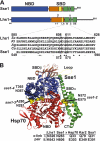
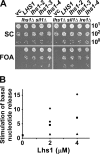
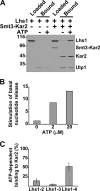
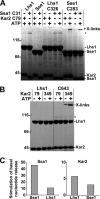
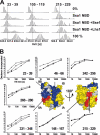

Similar articles
-
Insights into the structural dynamics of the Hsp110-Hsp70 interaction reveal the mechanism for nucleotide exchange activity.Proc Natl Acad Sci U S A. 2008 Oct 28;105(43):16519-24. doi: 10.1073/pnas.0804187105. Epub 2008 Oct 23. Proc Natl Acad Sci U S A. 2008. PMID: 18948593 Free PMC article.
-
The yeast Hsp110 Sse1 functionally interacts with the Hsp70 chaperones Ssa and Ssb.J Biol Chem. 2005 Dec 16;280(50):41262-9. doi: 10.1074/jbc.M503614200. Epub 2005 Oct 12. J Biol Chem. 2005. PMID: 16221677
-
Hsp110 is a nucleotide-activated exchange factor for Hsp70.J Biol Chem. 2008 Apr 4;283(14):8877-84. doi: 10.1074/jbc.M710063200. Epub 2008 Jan 24. J Biol Chem. 2008. PMID: 18218635
-
The hsp110 and Grp1 70 stress proteins: newly recognized relatives of the Hsp70s.Cell Stress Chaperones. 2000 Oct;5(4):276-90. doi: 10.1379/1466-1268(2000)005<0276:thagsp>2.0.co;2. Cell Stress Chaperones. 2000. PMID: 11048651 Free PMC article. Review.
-
The control of spindle length by Hsp70 and Hsp110 molecular chaperones.FEBS Lett. 2013 Apr 17;587(8):1067-72. doi: 10.1016/j.febslet.2013.02.018. Epub 2013 Feb 19. FEBS Lett. 2013. PMID: 23434584 Review.
Cited by
-
The Role of Endoplasmic Reticulum Chaperones in Protein Folding and Quality Control.Prog Mol Subcell Biol. 2021;59:27-50. doi: 10.1007/978-3-030-67696-4_3. Prog Mol Subcell Biol. 2021. PMID: 34050861 Free PMC article.
-
A chaperone trap contributes to the onset of cystic fibrosis.PLoS One. 2012;7(5):e37682. doi: 10.1371/journal.pone.0037682. Epub 2012 May 31. PLoS One. 2012. PMID: 22701530 Free PMC article.
-
The molecular chaperone GRP170 protects against ER stress and acute kidney injury in mice.JCI Insight. 2022 Mar 8;7(5):e151869. doi: 10.1172/jci.insight.151869. JCI Insight. 2022. PMID: 35104250 Free PMC article.
-
The Endoplasmic Reticulum Chaperone GRP170: From Immunobiology to Cancer Therapeutics.Front Oncol. 2015 Jan 12;4:377. doi: 10.3389/fonc.2014.00377. eCollection 2014. Front Oncol. 2015. PMID: 25629003 Free PMC article. Review.
-
The Lhs1/GRP170 chaperones facilitate the endoplasmic reticulum-associated degradation of the epithelial sodium channel.J Biol Chem. 2013 Jun 21;288(25):18366-80. doi: 10.1074/jbc.M113.469882. Epub 2013 May 3. J Biol Chem. 2013. PMID: 23645669 Free PMC article.
References
-
- Craig E. A. H. P. (2005) Protein Folding Handbook, pp. 490–515, Wiley, Weinheim, Germany
-
- Harrison C. J., Hayer-Hartl M., Di Liberto M., Hartl F., Kuriyan J. (1997) Science 276, 431–435 - PubMed
-
- Sondermann H., Scheufler C., Schneider C., Hohfeld J., Hartl F. U., Moarefi I. (2001) Science 291, 1553–1557 - PubMed
Publication types
MeSH terms
Substances
LinkOut - more resources
Full Text Sources
Molecular Biology Databases
Research Materials
Miscellaneous

